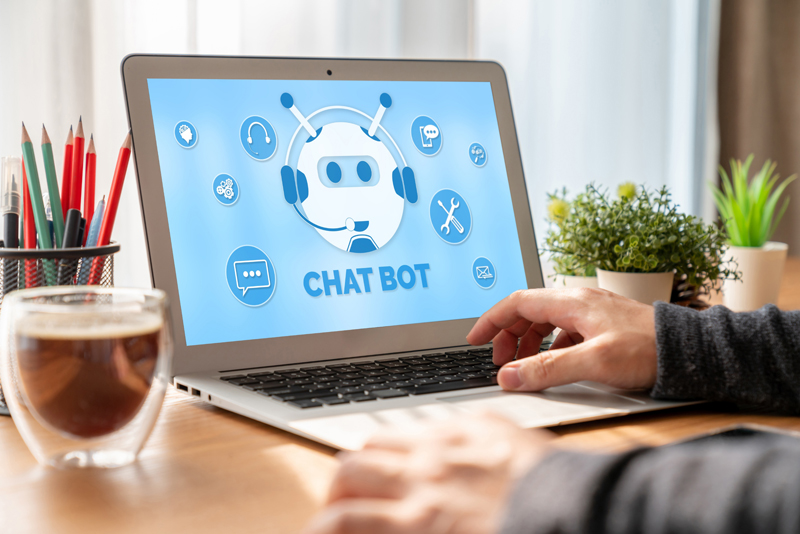Last week we talked about the many benefits to small businesses of using AI chatbots for customer service. Now we would like to address what is involved in AI chatbot implementation into small business operations.
Of course, a small business will want to have experts implement their AI chatbots, but it is helpful to understand the process and what to expect. Implementing AI chatbots is a strategic process that involves careful planning, execution and ongoing management. Here’s what needs to be done.
1. Analyze Your Business Requirements and Goals
Before you do anything else, you and your AI chatbot implementation experts will need to make a thorough assessment of your business needs and customer service objectives. You will need to identify the types of queries your customer service team frequently handles, the volume of inquiries and peak times for customer engagement. This assessment will help determine the scope of your chatbot’s capabilities and the problems it needs to solve.
Clearly define what you want your AI chatbot to achieve. Some examples of goals you might have are automating responses to common questions, assisting with bookings or orders, providing product recommendations and gathering customer feedback. Whatever goals you decide, they will guide the development process and serve as benchmarks for measuring success of the AI project.
2. Select a Chatbot Development Platform
Now you will need to decide on the right platform is crucial for the success of your AI chatbot. Consider factors such as ease of use, integration options with your existing systems such as your website and CRM software, customization capabilities, and cost. Some popular platforms (but certainly not the only ones) for small businesses include Dialogflow, IBM Watson Assistant, and Microsoft Bot Framework. You AI implementation expert should recommend what platform will best suit your company’s needs.
It will be necessary assess the technical resources available within your business. Some platforms require more technical expertise to set up and customize. If you are not outsourcing to AI implementation experts and are relaying on your inhouse technical staff, you will want to consider a platform known for its user-friendly interface and extensive support resources.
3. Design the Chatbot
The first step is conversation design, which involves mapping out the chatbot’s conversation flow, including how it will greet users, the types of questions it will ask and how it will respond to various user questions and comments. A well-designed conversation flow feels natural to users and efficiently guides them to the information or assistance they need.
You will also need to consider persona design. For example, do you want the chatbot to sound friendly and casual? Or maybe professional but helpful? Developing a persona for your chatbot can help make interactions more engaging for users. Decide on your chatbot’s name, tone and personality traits based on your brand identity and your audience’s expectations.
4. Plan Integration and Data Security
To make the best use of your AI chatbot, you will want to integrate it with your current systems. For example, the chatbot should be able to access prior conversations with the customer, access their buying behaviors and check on their orders to provide personalized service. This kind of service requires seamless communication between your chatbot and databases, CRM systems, inventory management software and other systems.
But giving your chatbot access to your systems and your customers means you must ensure the security of customer data your chatbot accesses and collects. Adhere to data protection regulations that apply to your company such as the General Data Protection Regulation or the California Consumer Privacy Act (CCPA) by implementing encryption, access controls and regular security audits. Clearly communicate your chatbot’s data handling practices to your customers to maintain trust.
5. Train the AI Model
A critical step in AI chatbot implementation is training. Use existing customer service logs, FAQs and product information to train your AI chatbot. This initial dataset should cover a wide range of possible queries and scenarios related to your business.
Your AI chatbot implementation experts should incorporate machine learning and natural language processing (NLP) capabilities to improve your chatbot’s understanding of user queries and its ability to provide accurate responses. So training will improve performance, but your chatbot should also learn continuously from interactions with customers. Your experts will likely review chat logs to identify areas for improvement and when your chatbot needs to be retrained with new data.
6. Test, Test, Test
Before public deployment, conduct thorough internal testing to identify bugs, unnatural conversation flows and comprehension issues. Use a variety of test cases to cover as many potential user interactions as possible.
Consider launching a beta version of your chatbot to a limited audience. Collect user feedback on the chatbot’s performance, focusing on areas such as understanding user queries, conversation flow and overall user satisfaction.
Use insights gained from testing to refine your chatbot. This may involve adjusting conversation flows, retraining the AI model, or adding new functionalities. This will be a continuing process.
7. Determine Where Customers Can Access Your Chatbot
Decide where you want your customers to access your chatbot. For example, specific pages of your website, social media platforms and messaging apps. Make it easy for your customers to find your chatbot.
8. Define Escalation to Human Agents
There are some issues that chatbots can’t handle due to complexity and need for human intervention. Therefore, your AI chatbot implementention experts must set up escalation protocols to transfer users to human agents when necessary. You may also want to enable your users to choose to escalate themselves when necessary.
9. Monitor and Manage
You will need qualified personnel to regularly monitor your chatbot’s performance using metrics such as user satisfaction scores, resolution rates and conversation abandonment rates. This data will help you identify trends and pinpoint areas for improvement.
At the same time, your organization can greatly benefit from seeking direct feedback from users about interactions with the chatbot. This can be done through follow-up surveys, feedback forms embedded in the chatbot conversation or an option to rate the chatbot’s responses. User feedback is invaluable for understanding the user experience from a first-hand perspective and identifying specific issues or areas for enhancement.
10. Update Your Knowledge Base
As your products, services, or policies change, update your chatbot’s knowledge base accordingly. This ensures that the chatbot provides accurate and up-to-date information. Regularly reviewing and updating the content and conversation flows can also help keep the chatbot aligned with your current business objectives and customer needs.
11. Set Up Ongoing Training
AI chatbots, especially those powered by machine learning algorithms, require continuous training to improve their understanding and handling of customer queries. Incorporate new queries, slang or phrases that users frequently use into the chatbot’s training data. Analyzing chat logs can reveal trends and common issues that the chatbot may not be adequately addressing, informing the direction for further training.
12. Ensure Scalability
As your business grows, your chatbot will likely experience an increase in user interactions. Ensure that your chatbot and the underlying infrastructure are scalable to handle growing demand without degradation in performance. This might involve optimizing the chatbot’s code, upgrading your hosting plan or using cloud services that automatically adjust resources based on traffic.
INLocal Marketing Experts Can Help You with AI Chatbot Implementation
Implementing an AI chatbot for a small business involves a blend of strategic planning, technical development and continuous improvement. You are busy running your company, but INLocal Marketing experts can do all this for you. To schedule a free consultation, complete the form on our website or call (646)440-1426.






